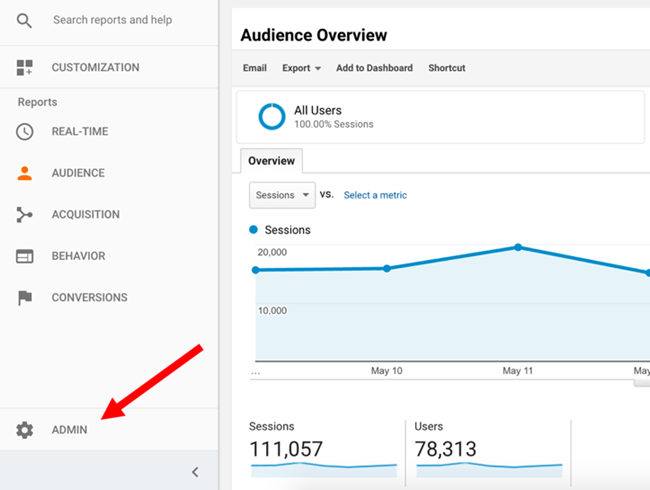Step-by-Step Tutorial: Remarketing In Google Analytics
Step-by-Step Tutorial: Remarketing In Google Analytics
Blog Article
Remarketing in Google Analytics: Transforming Visitor Information Into Sales
The capability to specifically target audiences based on their actions and choices opens up doors to a realm of possibilities, pushing organizations in the direction of lasting development and earnings. Through a careful analysis of visitor actions and a customized remarketing method, services can navigate the digital landscape with accuracy and finesse, deciphering the true potential of their online presence.

Advantages of Remarketing in Google Analytics
Remarketing in Google Analytics supplies organizations the chance to reconnect with web site visitors that have shown rate of interest in their services or products, thereby enhancing brand presence and conversions. By leveraging this powerful device, services can remain top-of-mind with prospective clients that have already involved with their site. One of the key benefits of remarketing is the capability to target certain target markets based upon their actions on the web site, enabling individualized messaging and tailored marketing campaign.
Additionally, remarketing in Google Analytics can aid businesses raise their conversion prices by re-engaging with site visitors that may not have actually bought or finished a desired activity on the site during their first browse through. This targeted strategy can result in greater conversion rates and ultimately drive even more sales. In addition, remarketing can likewise help services develop brand commitment and count on by keeping constant communication with possible clients throughout their acquiring journey.
Establishing Remarketing Projects
When starting remarketing projects in Google Analytics, organizations need to very carefully prepare and implement calculated targeting strategies to effectively reach their desired target market. The primary step in establishing up remarketing campaigns is to define clear purposes. Whether the goal is to raise site conversions, advertise details products, or raise brand name awareness, having a distinct objective will certainly direct the entire project technique.
Next, companies need to create audience checklists based upon specific standards such as web site visitors, individuals that abandoned their buying carts, or those that communicated with particular material. These checklists permit targeted messaging customized per section of the audience, boosting the chances of conversion.

Lastly, services should establish conversion tracking to gauge the success of their remarketing projects accurately. By assessing the performance data, companies can maximize their advocate much better results and greater ROI.
Leveraging Target Market Segmentation for Remarketing
Utilizing target market segmentation is a vital technique for enhancing the efficiency of remarketing campaigns in Google Analytics (What Is “Remarketing” In Google Analytics?). By dividing your website visitors into distinctive teams based on their behavior, demographics, or passions, you can tailor your remarketing efforts to target these particular sectors with pertinent ads. Target market division allows you to create more tailored and targeted campaigns, boosting the possibilities of re-engaging site visitors and driving conversions
Segmenting your audience enables you to deliver customized messaging that resonates with each team's requirements and choices. For instance, you can create separate remarketing lists for individuals who abandoned their shopping carts, saw specific product web pages, or downloaded a particular source. By understanding the different inspirations and passions of these segments, you can craft compelling ad creatives that are a lot more most likely to capture their focus and motivate them to review your website.
In addition, audience segmentation additionally assists you maximize your ad invest by concentrating on high-value sectors that are most likely to convert - What Is “Remarketing” In Google Analytics?. By analyzing the efficiency of each sector, you can designate your budget plan better and optimize the return on your remarketing financial investment
Studying Remarketing Performance Metrics
Metrics such as click-through price (CTR), conversion price, expense per procurement (CPA), and return on advertisement invest (ROAS) offer important insights right into the efficiency of your remarketing initiatives. CPA helps determine the expense of acquiring a client via your remarketing project, while ROAS analyzes the revenue generated for each dollar invested on marketing. By over here examining these metrics, you can recognize locations for improvement, maximize your projects, and allot spending plan extra efficiently to make the most of the ROI of your remarketing approaches in Google Analytics.

Best Practices for Remarketing Success
Structure on the foundation of assessing remarketing efficiency metrics, carrying out ideal practices is vital to accomplishing success in your remarketing endeavors. One critical ideal practice is to segment your audience properly. By dividing your audience based upon their behavior, demographics, or interests, you can create customized messaging that reverberates with each sector, eventually enhancing the likelihood of conversion. Furthermore, guarantee that your remarketing advertisements are aesthetically enticing and include engaging phone call to activity. Catching the user's attention and triggering them to take the preferred action is important.
Moreover, regularity covering is vital to avoid ad fatigue. Bombarding customers with the exact same advertisement consistently can lead to aggravation and reduced effectiveness. Checking various ad positionings, styles, and messages is also important. A/B screening allows you to identify which strategies produce the most effective results and optimize your projects appropriately. Check your campaigns regularly, analyze the data, and make data-driven choices to continually refine your remarketing efforts for optimal impact.
Final Thought
To conclude, remarketing in Google Analytics supplies businesses the opportunity to take advantage of visitor data to increase sales and drive conversions. By using audience division, examining efficiency metrics, and applying best techniques, businesses can tailor their remarketing initiatives to target high-value sections successfully. Through engaging ad creatives and conversion tracking, businesses can develop brand loyalty and trust, eventually he said making the most of the effect of their marketing techniques.
With a meticulous evaluation of visitor actions and a tailored remarketing strategy, organizations can navigate the electronic landscape with accuracy and skill, unraveling the true potential of their online visibility.
One of the key benefits of remarketing is the ability to target particular audiences based on their actions on the site, permitting for customized look at this now messaging and tailored advertising projects.
In addition, remarketing can likewise aid organizations build brand name commitment and trust by preserving regular interaction with possible consumers throughout their acquiring trip.
Metrics such as click-through price (CTR), conversion price, expense per procurement (CERTIFIED PUBLIC ACCOUNTANT), and return on advertisement spend (ROAS) give beneficial insights into the efficiency of your remarketing efforts. By analyzing these metrics, you can determine locations for improvement, optimize your campaigns, and allot budget plan extra effectively to make the most of the ROI of your remarketing techniques in Google Analytics.
Report this page